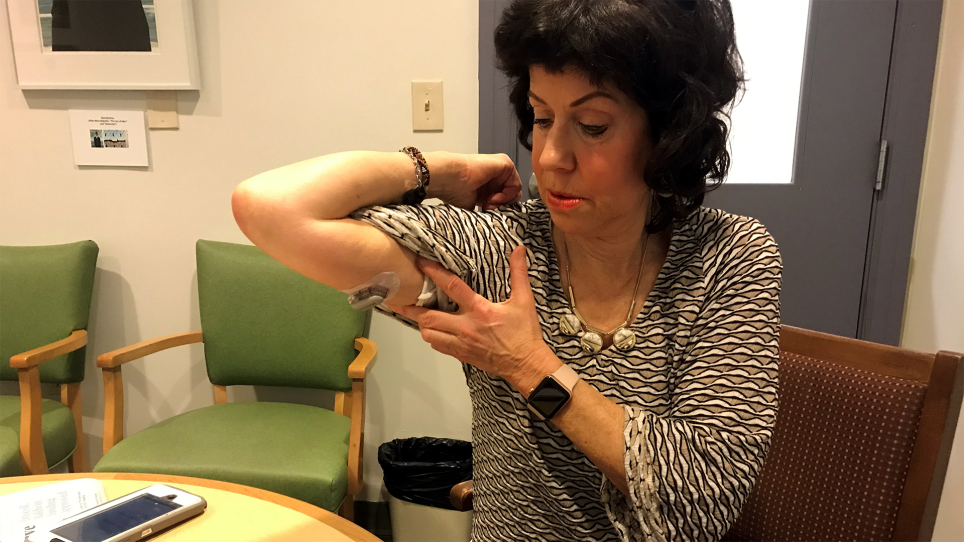Myranda Pierce of Jamaica Plain is in the unenviable position of having to choose between buying the medication she needs to live or paying her bills.
"I cannot afford the insulin that these companies make," she said. "These companies have priced their insulin so high that it is more than my rent.”
Pierce, 31, has Type I diabetes and doesn't have health insurance — "Yes, even in the state of Massachusetts," she said.
"We all know MassHealth is amazing, but it does take time to kick in," said Pierce, a graduate student at Boston University School of Medicine. "I recently, and many times during my life, rationed my insulin. “
The average price of insulin nearly tripled between 2002 and 2013, according to the American Diabetes Association. The cost of a single vial of insulin varies, but patients with insurance can pay as much as $300 for one that may only last a week or two. A 2018 study showed that the cost of insulin results in nearly 25 percent of all patients adjusting their prescription. Because of the high cost, some people with diabetes, like Pierce, are rationing their insulin — taking less than they should to make the supply last longer.
Pierce said she and others turn to the black market to buy insulin at cheaper prices than drug stores. Some drive to Canada, while others share expired insulin through an online medical community. They lay blame for all of this on drug makers who, they say, put profit over patients.

On a recent day at the Brookline Senior Center, Deidre Waxman of Newton sat at a table with her flowered, toiletry-sized bag that holds all her medical supplies. Inside the bag was everything Waxman needs — glucose test strips, a lancing device, lancets, insulin pen, and a button meter — to keep her blood sugar at safe levels. It's a lot of equipment the 66-year-old social worker didn't need even just a few years ago.
“It’s a 6-year-old diagnosis," Waxman said. "And it’s a shock when you get it, because there’s no reason to think you’re going to get it.”
Managing her finances is now a lot of work. Waxman has Medicare, but no private insurance. Medicare will pay up to $3,700 a year for all of her medical expenses, she said. But once that’s exhausted, she's on her own to try to cover the approximately $12,000 that she needs for her insulin.
In November, a coalition of activists, including the mothers of two children with diabetes who died while rationing insulin, protested the high costs of insulin outside the Cambridge offices of Sanofi, one of three major drug companies manufacturing the drug. The other two are Eli Lilly and Company and Novo Nordisk.
But, why is a drug that’s been around for more than 100 years now so expensive?
WGBH News reached out to Sanofi about rising insulin prices. The company sent a video and a statement saying it's exploring ways to reduce out of pocket expenses, including expanding a program that offers "qualifying patients the opportunity to obtain two of Sanofi's insulins at a set price" of $99 for a 10 milliliter vial. Since April, more than 6,500 people have enrolled in the program.
"When we initially launched the Insulins VALyou Savings Program, our goal was to support as many uninsured and underinsured people living with diabetes as we could, and we pledged to explore how to increase affordable access in the future," said Michelle Carnahan, an official with Sanofi. "We're making good on that pledge today by expanding this program. While we are off to a good start, we know that many people continue to look for more affordable insulin options. We hope the expansion and increased awareness of this program will allow more people to benefit from it."
However, critics note that there are more than 30 million people — almost 10 percent of the entire U.S. population — living with diabetes in America. The income cap on the savings program means large numbers of uninsured and underinsured people still don't have access to affordable diabetes medications, they argue.
Dr. Rob Gabbay, chief medical officer of Boston’s Joslin Diabetes Center, said setting the price of insulin is complicated and not easily understood. He said it involves pharmaceutical companies, benefit managers and payers, and that’s why he’s recommending greater transparency in pharmaceutical price setting.
“There are a number of different players in the supply chain,” Gabbay said. "Each of them have the potential for a markup, and we don’t know where that really is."
With such large numbers of Americans dealing with diabetes, lawmakers are getting involved.
Sen. Elizabeth Warren introduced legislation to reduce drug prices through public manufacturing of prescription drugs. The bill, called the Affordable Drug Manufacturing Act, is considered an ambitious proposal to address the skyrocketing price of prescription drugs. Rep. Jan Schakowsky of Illinois introduced identical legislation in the U.S. House of Representatives.
At the state level, Massachusetts Rep. Kate Hogan introduced legislation to make insulin more affordable, and a group of attorneys general, including Maura Healey, is now investigating collusion among drug manufacturers.
Waxman said this is all encouraging, but for now, she’ll continue to help others who can’t afford their own. She knows how much the lack of insulin can put someone's life in jeopardy.
“It’s not an easy thing to cop to … but I have to say, last week, me and a friend sent out every single bit we had left to somebody who was desperate in Colorado," she said.



